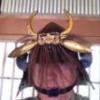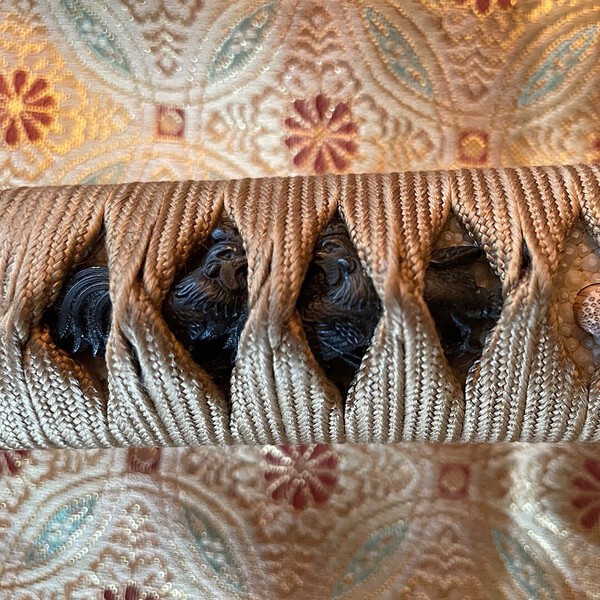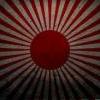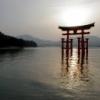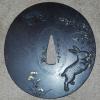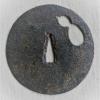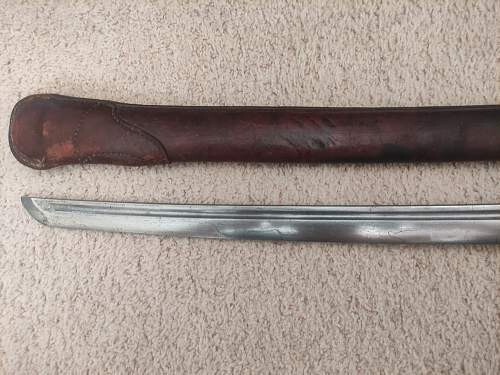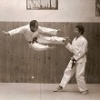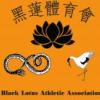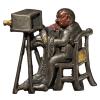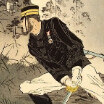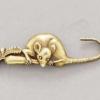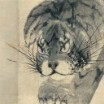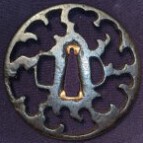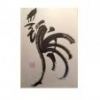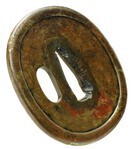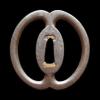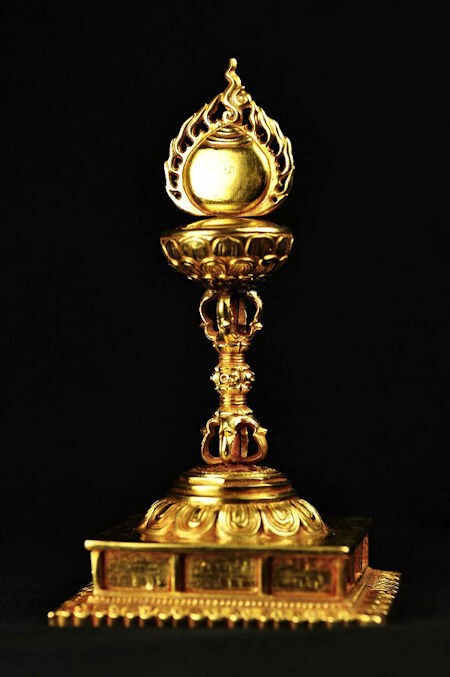Leaderboard
Popular Content
Showing content with the highest reputation on 01/14/2022 in all areas
-
I went and did the thing that everyone tells you to avoid doing. I had new koshirae made for a katana. I used a set of tosogu from the Edo Period. The Fuchi Kashira is signed by Yoshikawa Mumemitsu. The Tsuba and Menuki are unsigned but the Menuki are attributed as Denjo by the NBTHK. I’m calling the koshirae “The Chicken.”7 points
-
Knowing the maker is always good and important, and in this case the maker seems to be a smith of some skill, so I wouldn't say this is insignificant. Also, the unique design on the tang, and even the "good luck" inscription on the reverse side, will all be interesting to collectors. For sure get a new mekugi. Many of us here on the board just whittle down a piece of bamboo chopstick when a new one is needed. (Nobody is a purist regarding the menuki...any piece of bamboo will do as long as it stays in place and holds the sword in). Regarding restoration, for now I wouldn't be in a rush. Just keep it oiled very slightly (so that a film covers the sword, but not enough to allow the oil to collect and pool and potentially drip inside the saya). With Shōwa blades, restoration is always a dicey proposition because the cost of restoration may not be recovered when reselling. I know you are not considering reselling, but it is a data point that someone will eventually consider. I don't know too much about Kanemitsu, but the inscription is unusual enough, that the sword may well be worth spending the couple of thousands of dollars on restoration. Think about this for a while, get some more opinions, show to some collectors or dealers in your area.3 points
-
Well if you read right to left it’s 友長 Tomonaga, but left to right would be 長友Nagatomo. There was a Myōchin line Tomonaga with those characters 友長 in Sendai at the end of the Edo Period3 points
-
Astute observation. Had a quick look and agree, definitely a mutt. Kobe range from 37k to 39k, so blade does not match the fuchi. The saya doesn't match blade or Kobe range numbers either. The habaki doesn't appear to fit, so agree there, though it does look as though the seppa is removed in the photo, so could just be not fitted together? It looks a bit sanded though and shape is bad. As I mentioned, the Kobe I have and have seen all look excellently made, great examples. Don't really see anything obvious about the tsuka or tsuba being reproduced, but the photos would been to be a bit larger and show more detail. I am also looking on a phone, so small screen. The leather on the tsuka looks pretty genuine though and it's not something I've seen faked on 95s. Is there anything in particular that stands out, @Stegel? At best, this is a parts sword, at worst, there may be some replacement parts. Either way, such a shame as a leather clad sword like this would lovely to see, if original. I wonder if this is a Monkey special?3 points
-
Cluck, cluck, cluck of approval. Where is the Nihonto Chicken for his cluck?? Charles, this is a stunner. I'm sure there is a wonderful story of who did the work, where, and how long it took. Charles wrote: > I went and did the thing that everyone tells you to avoid doing. I had new koshirae made for a katana Well, if one uses the right artisans the result speaks for itself. BaZZa.3 points
-
Just some ponints to consider here: Aoi Art works with stock in Japan and in almost all cases these swords have been looked after better than some in the West so the nakago patina is less marred by active rust. They also stock swords from all periods, increasingly more recent ones so nakago from Shinshinto might well look very clean, from WWII swords even more so, shinsakuto of course. Cleaned nakgo are a big downpoint so any swords that had been so abused would have had the patina restored. I have seen clean nakago on the website, but not cleaned, and no Japanese polisher would ever do such a thing. Hope that helps. All the best.2 points
-
Now I know how the German militaria dealers started to feel towards the end. (By end..I mean the time where the average person couldn't actively collect properly anymore due to the fact that the copies have become so good, only the top experts can tell them apart. )2 points
-
2 points
-
Yes - BUT - since when did roosters lay eggs??? Hmmmm??? Hmmmm??? The ideal kashira would be - a henpecked hen!!! BaZZa (in a cheeky mood)2 points
-
Noshu Seki ju Tanigawa Ishin saku2 points
-
Bugyotsuji stamp of approval. Bringing things back to life. Well done.2 points
-
The sword is not genuine, it is made up from original parts. The fuchi does not belong with this sword and neither does the habiki looking at extra pictures over at war relics, i would go so far as to say that the originality of the tsuka and tsuba is also doubtful.2 points
-
2 points
-
2 points
-
AH! Now I see it! Due to the photo I couldn't quite make out the upper part of the YASU character. Also totally bungled the Province, but at least I got most of the other characters right. Interesting that MAKIYO was used on some blades. I wish I had better pictures. The "delta" stamp is also interesting as well. 尾 州 住 真 清 正 泰 鍛 之 - BISHU JU MAKIYO MASAYASU KITAU KORE2 points
-
2 points
-
Steve, found this fully leather-wrapped Kobe 95 on this Warrelics Thread. Also interesting was the owner's observation that the tsuka details were poor, aligning with what we've learned that the Kobe shop losing their contract because of poor workmanship. It also has the double chevron or "W" stamp on the nakago!2 points
-
IMO, shinsa for tsuba is very different from sword shinsa: - Hozon: very easy if it is a genuine tsuba, (as for sword shinsa) no great interest, IMO, not worth the expense. If it is for a school attribution, just ask NMB specialists. - Tokubetsu Hozon: very very difficult, a mei is really a plus. Have a look at the price of TH tsuba - juyo: often kinko by major schools and artists. Price equal to some juyo swords There is a huge gap between Hozon and TH, which does not exist in sword shinsa and between TH and Juyo an abym. has anyone the stats of tosogu shinsa, It can be very interesting. Of course, it is only my opinion and I don’t know anything about tsuba.1 point
-
Tough call. There are better and better craftsmen making replicas (dare I say undeclared utsushi) where it has become hard to be 100% sure, other than the obvious fakes. It is a handsome tsuba after all. John1 point
-
Bob, Did the seller actually state it was edo period/authentic in his writeup, or did he use the usual "I don't know what this is, do your own due diligence" verbage? If its the former, you might be able to contact buyee, point out that the guy lie-er, was mistaken about its age/authenticity, and ask them to ask the seller to take it back (though that's a long shot unless they really buggered their listing). Best, rkg (Richard George)1 point
-
sorry i didn't mean to hijack the thread so will give my best guess (answer) to your question: From looking at the other thread my explanation for the kanji would be that the blade has always been viewed as a "utilitarian" blade. It may have been part of a castle or arsenal's "stock" of weapons, something stored and issued to someone when needed. The markings may be something used to organize, inventory, track etc the blade. You see kanji like that on blades used in the Satsuma rebellion in later 1800's1 point
-
This is one of those regular questions, and we all have our own opinions. Best general supplier of sword care products is https://www.namikawa-ltd.com/ if it's good enough for the imperial family, then it's good enough for anyone. Regarding oil, I use Kurobara, there are various suppliers of it, and it's the oil used by https://www.aoijapan.com/ in their sword care videos. Uchiko is "one of those things", and I heard it recommended by collectors, up until a few years ago, but not any more. The backyard cutters use it to clean their blades of sticky residue from plastic bottles and ties etc, but they are a special case. Otherwise received wisdom is don't touch a blade in polish with it, but uchiko the hell out of a blade in bad condition as opposed to using any other abrasive. Just my two-penny-worth.1 point
-
Hi John something comparable, I think so1 point
-
Sometimes you will see both Mon & family name, pretty rare but as good as you will get.1 point
-
Volker my pleasure , just happened to have the very book in my office drawer , i hope it is what you were looking for .1 point
-
Yes indeed Thomas If we have the mon - which family name goes with it? If we have the name - which mon goes with it?1 point
-
1 point
-
Putting together a koshirae is fine when done by the right people with the right knowledge. In this case, was done right. I like it a lot.1 point
-
1 point
-
The only Uchiko I would trust was would be the one personally made by Robert Benson. You can find it http://bushidojapaneseswords.com/store/p363/Small__Polishers_Uchiko_Ball__.html Unfortunately it’s out of stock and I wouldn’t trust anything else that would risk being coarser.1 point
-
Well of course they don't my friend! To me the eggs represent the hen, which is part of why I love them as a companion to the rooster fuchi 😉🥚🐓🥚1 point
-
1 point
-
1 point
-
1 point
-
1 point
-
The dimple at the bottom of the seppa-dai would suggest that at the very least three are copies [more likely all four]. Why would you make a 'mistake' four times? Other details are not the same, such as the part of the signature immediately above - would this suggest the signatures were added after the casting or just the die wearing out? Bob, it is nearly impossible to tell authentic pieces in isolation, some copies are just so good. It is only when they start to multiply that they start to stand out - a good visual search of similar pieces will often lead you in the right direction but finding them can take a long time.1 point
-
If it is convention not to create beauty, then to hell with convention! Great job! [But could you take the images with a less camouflaging background ]1 point
-
Yoshihiro TSOIL 100% Pure Tsubaki Japanese Knife Maintenance Oil With Complimentary Sabitori Rust Eraser, 3.4 oz, Large, Golden Yellow https://www.amazon.com/dp/B00AZ6SYSY/ref=cm_sw_r_apan_glt_fabc_4ZNNXWQK4466ESEPMQ81 Or you can buy just the oil. This is handy because you get just right size microfiber. Do not I repeat do not be tempted to use that little rust eraser LOL on anything except your kitchen knife or bonsai tools. https://www.amazon.com/dp/B00362HBPQ/ref=cm_sw_r_apan_glt_fabc_JRX6AMDBSAT5P6E88FS51 point
-
1 point
-
David, looks like Masayasu (Mano as Makiyo) also with "delta" punch, and very "chippy" cutting. See this article page 381 point
-
Dear Daniel. Glad someone on the NMB snagged that one, I think it's very well done, even more so when you regard the back of it, you can almost hear the hooves on the bridge planks! Congratulations! All the best.1 point
-
A perfect illustration of the folly of trying to associate a mon with any single family... -tch1 point
-
Japanese steel is more sensitive than regular monosteel and requires better quality items to care for it. I wouldn't trust the quality of any 'care kits' sold on Amazon. You'd likely just end up ruining the polish using that stuff.1 point
-
An interesting thread indeed. The UK is fortunate in that contact with Japan occurred not only during the 16th and 17th centuries, but also very soon after Japan was 'opened ' during the 19th century. For a while during the late 19th century there was a considerable interest in Japanese art and culture during which a considerable quantity of Japanese art of all types, including swords and fittings, was imported into the UK. Retailers such as Liberties in London sold vast quantities of lacquer work and other treasures, and if stories are to believe, even used woodblock prints as wrapping paper. Other tales are told of tsuba, tied in dozens on a string, being sold on the London docks, having served as ballast in ships. There is even a fleeting mention of a Japanese armour in one of the Sherlock Holmes stories. All this points to the fact that there still remains a considerable number of armour, swords and considerable quantities of fittings in the UK. We are also fortunate in that some of the earlier collectors have left a corpus of valuable reference material in publications such as the Journal of the Japan Society. This initial enthusiasm for all things Japanese dwindled around the close of the 19th century, becoming positively antagonistic after WWII. It is to such people as B.W. Robinson, whose writings during the post war period, rekindled the current widespread interest. To this earlier category must be added the not inconsiderable number of swords brought back by soldiers who fought in the Far East during WWII. All of this preamble leads up to the obvious statement that we in the UK are blessed in living in a country rich in swords, armour and fittings. Whist there now exist severe restrictions on the acquisition of swords from abroad, plenty of swords are available at arms fairs and many more are available from public auctions. Some of these items are of considerable merit, many having belonged to those who began collecting after WWII and who are now dying off. There are lots of good items out there if you take the trouble to learn what is worth having. Ian Bottomley1 point
-
1 point
-
1 point
-
Would I be correct in saying that the 'teardrop' shape at the top of the mei is a tama, in this case as drawn it represents the Jewel of Knowledge with flames rising from it??? This is the same tama as in tamahagane... Any more 'enlightenment' on this??? A very interesting signature indeed. BaZZa.1 point
-
春日製造所文忠作 Kasuga Seizōsho Fumitada saku This may be the same smith as Harumoto mentioned on the site below. https://www.japaneseswordindex.com/gendai2.htm Would like to see the date side without the boxes on it. I think you have the date right, but the "kore" by itself at the end doesn't make sense.1 point
-
1 point
This leaderboard is set to Johannesburg/GMT+02:00

